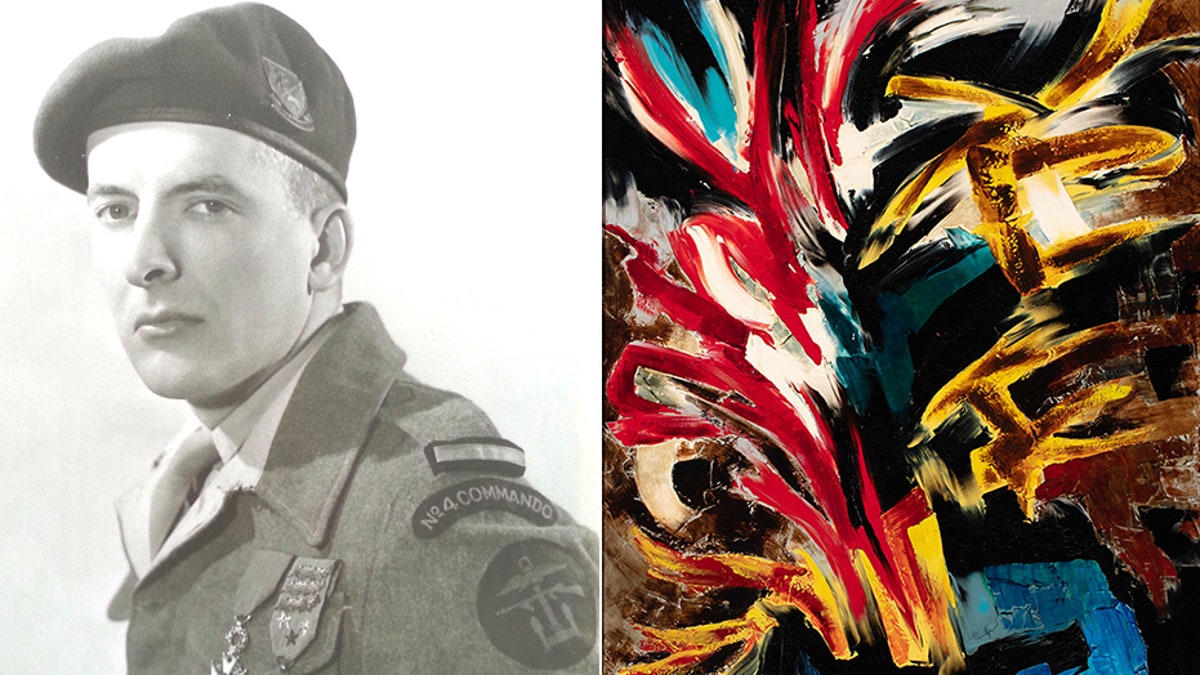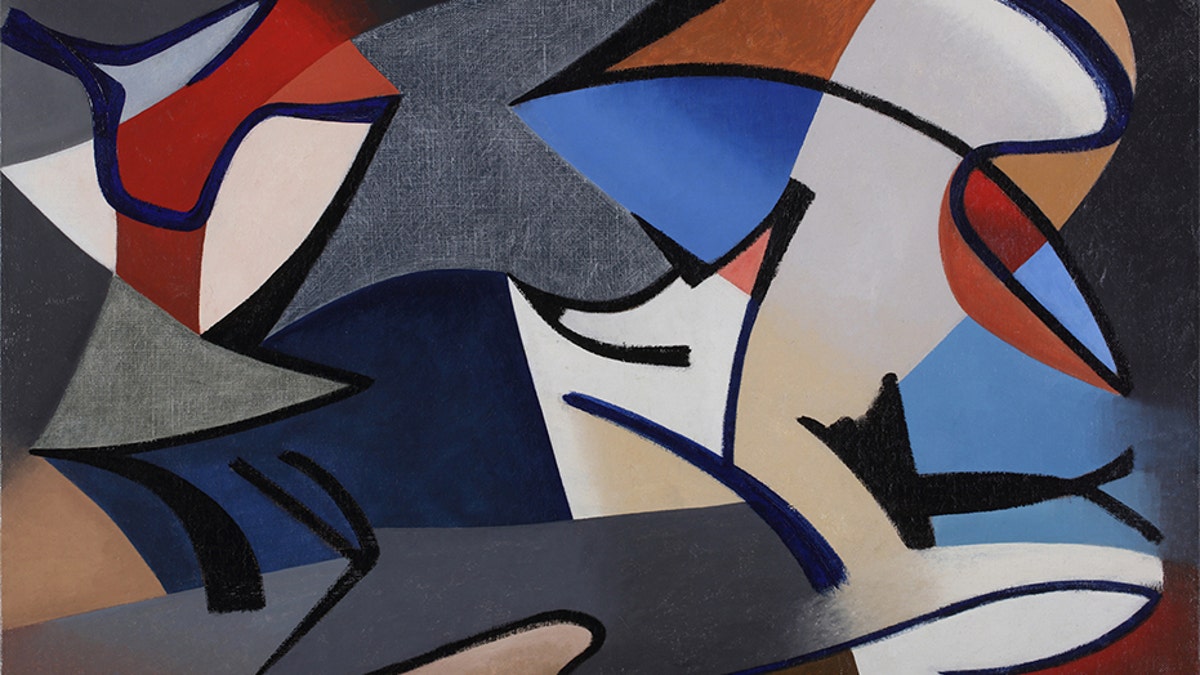
Guy de Montlaur, a French World War II soldier, has a series of his paintings now on display at the National World War II Museum in New Orleans. At right is his 1957 painting "Fire", which the Museum says is titled as a "reference to his wartime experiences". (National World War II Museum/Courtesy Montlaur Family)
Guy de Montlaur grew up knowing he would have to “fight the enemy”, but when he experienced the horrors of World War II firsthand, his life – and the art that he made – would change forever.
The French painter-turned-soldier took part in D-Day, battled a German in hand-to-hand combat and lived out the rest of his life with shrapnel in his face after being struck by cannon fire during an amphibious invasion of a Nazi-held Dutch island. Now, the National World War II Museum in New Orleans is honoring his life and art with a special exhibit that also delves into the efforts the U.S. military made at the time to diagnose and treat combat stress.
“Everything that he felt during those years -- the anger, the terrible things he saw during the fighting, is translated into his art,” his daughter, Dauphine Sloan, told Fox News.

A self-portrait Montlaur made in 1939, during the outbreak of World War II, then another one he did of himself around 30 years later. What he saw during the battles would later play a pivotal role in the art he created. (Courtesy Montlaur Family)
The late Frenchman’s abstract paintings that are now on display, with titles like “One June early morning” – a nod to D-Day – and “fire”, are colorful, emotional and foreboding. Sloan says his art is a “testimony to what it was like to have those experiences.
“He’s not alone,” Sloan told Fox News. “He is just one person, he was lucky to have this talent and put it all in his art.
“A lot of people are not able to get it out of their system and they keep it to themselves and it drives them to a life of depression or a lot of difficulties,” she added.
Born in 1918, Montlaur was always told stories of how his family members fought in World War I, where his father survived being gassed by German forces. Montlaur took a keen interest in drawing and painting while he was young, and would spend time touring the sprawling Louvre Museum in Paris.
Montlaur later went on to learn oil painting techniques at an art academy in the area, but when World War II broke out, he was ready to defend his home, Sloan says.
“He grew up with this idea that the enemy was right next door and… he would have to fight the enemy,” she told Fox News. “When the war started in September 1939 he was just at the right place and for him that was a good thing, he was never afraid.”

Montlaur's 1977 painting "One June Early Morning", which the Museum says references D-Day, which he took part in. (Courtesy Montlaur Family)
Montlaur put down his paintbrush and left behind the art he created before the war – which included landscapes, horse scenes and portraits – and joined the French Army for a cross-border invasion of Germany.
The following year, the Germans overwhelmed the French and Montlaur eventually made his way to England -- by way of Spain and Portugal -- to link up with the Free French Forces, under the command of exiled General Charles de Gaulle, the museum said.
Montlaur then became a sergeant in the Fusiliers-Marins Commandos (Marine Riflemen Commandos), a unit of more than 170 Frenchmen who would go on to suffer 25 percent casualties during their landing on Sword Beach on D-Day. His role there – where he was wounded twice -- later was portrayed by French actor Georges Riviere in the 1962 war film “The Longest Day”.
Montlaur pushed on in the Normandy campaign for more than two months and saw his last combat in November 1944, during an amphibious invasion of the heavily-guarded Dutch island of Walcheren.

This 1969 painting titled "Il dort" (he is sleeping), is Montlaur's "rendering of a fallen comrade on D-Day", the Museum says. (Courtesy Montlaur Family)
The Museum says Montlaur’s landing craft was hit by German cannon fire during that fight, piercing his face with shell fragments, killing seven men onboard and causing it to sink around 150 feet offshore. Despite the injuries, Montlaur went ashore and fought with his unit in a house-to-house battle to secure the island, wanted by the Allied forces for its port.
For his service, Montlaur received the French Croix de Guerre -- an award for valor -- and the Legion of Honor, the country's highest award for military and civil merits.
After World War II ended, Montlaur once again picked up his paintbrush. From then until his death in 1977, at age 58, his art was influenced by his extensive combat service. A car accident he was involved in during the 1960s also caused his wartime trauma to resurface, the museum said.
“I want to shout: ‘Just look! Look at this mystery! It pierces the eyes!’ And nobody sees it. Nobody but me. People see colors, shadows, lights, forms. They see (but what do I know they really see?) the canvas, the stretcher nails,” he wrote about his work, according to the museum. “And I don’t understand why they can’t guess at all the distress here, right in front of them, as it was during the war: the noise, death, love, betrayal; the lies, and the fear. And still, more than I cannot say, but I know how to do it.”
WWII US AIRMEN WHO DIED SAVING BRITISH CHILDREN HONORED WITH FLYOVER 75 YEARS ON
Sloan told Fox News that “he never explained his paintings because for him everything was there.
“We grew up with our own interpretations, he told us you can see in these paintings whatever you like, just figure it out,” she said.

Montaur's 1951 "Composition Beach" painting. The Museum says "Colleville Beach was Montlaur’s inspiration" for this work, and "in 1944, the beach at the village of Colleville-sur-Mer was code-named Omaha and was the scene of some of the heaviest fighting on D-Day." (Courtesy Montlaur Family)
The exhibit at the museum, titled “In Memory of What I Cannot Say: The Art of Guy de Montlaur,” will showcase archival photography, artifacts from the time of war in which Montlaur served, and video segments from John Huston’s 1946 documentary Let There Be Light, which analyzes WWII veterans who suffered from combat stress.
The condition is defined by the U.S. Department of Veterans Affairs as: “A state of mental or emotional strain or tension resulting from adverse or very demanding circumstances related to combat operations.”
Larry Decuers, the exhibit’s curator, told Fox News it will also feature a letter from an American soldier expressing his desire to undergo electroshock therapy, believing it would help him erase the memories of combat.
Decuers says World War II soldiers who were burnt out from fighting – causing some to shake all over -- often would be whisked away from the front lines to stations set up within earshot of the battlefield. There, they would be given drugs like sodium amytal, which would induce them into a prolonged sleep.
After waking up, the soldiers would be given a shower, a clean uniform, a hot meal and a re-evaluation. Around 30 percent of the time, Decuers said, that treatment wasn’t enough and the troops would be evacuated to hospitals and never see combat again. But for most, they returned from the stations to the battlefield.
CLICK HERE TO GET THE FOX NEWS APP
“It probably wasn’t the best thing for the soldiers, but considering they were having a manpower crisis at that point, they needed everyone they could get,” Decuers said.
The exhibit will run through Oct. 20 and the Museum says it will be “further explored through a robust schedule of free public programming and educational initiatives, all produced in partnership with local veterans groups and art institutions.”





















